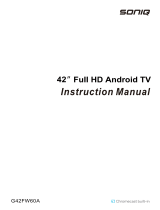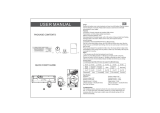
Internet Connection
Establishing a Wired Internet Connection
44 Connecting a LAN Cable
45 Connecting to a Wired Internet Network Automatically
45 Connecting to a Wired Internet Network Manually
Establishing a Wireless Internet Connection
47 Connecting to a Wireless Internet Network Automatically
48 Connecting to a Wireless Internet Network Manually
49 Connecting to a Wireless Internet Network with WPS
Troubleshooting Internet Connectivity Issues
50 Troubleshooting Wired Internet Connectivity Issues
51 Troubleshooting Wireless Internet Connectivity Issues
Checking the Internet Connection Status
Smart Features
Multiple Functions on a Single Screen
53 Launching Multi-Link Screen
53 Using Multi-Link Screen
53 Selecting a Feature
53 Changing the Channel/Volume
54 Pairing Bluetooth Headphones
54 Selecting the Audio-Source Screen
Smart Hub
56 Using the Smart Hub Tutorial
Using Smart Hub with Samsung Account
57 Creating a Samsung Account
59 Signing into Samsung Account
60 Linking My Samsung and App Accounts
61 Changing and Adding Information to Samsung Account
61 Deleting All Samsung Accounts from the TV
Using the NewsON Panel
62 News
62 Weather
Using SAMSUNG APPS Panel
64 Using Pop-Up Menu Functions
65 Installing an App
66 Default Apps
66 Rearranging Apps on the SAMSUNG APPS Screen
67 Removing an App from the TV
67 Rating/Reviewing an App
68 Updating an App
68 SAMSUNG APPS Features
Using FILMS AND TV SHOWS Panel
71 Using Pop-Up Menu Functions
72 Watching a Movie/TV Programme
72 Registering Content to Favourites
73 Rating and Sharing a Purchased Content
Playing Photos, Videos, and Music (MULTIMEDIA)
74 Playing Media Content from a USB Device
75 Playing Multimedia Content Saved in a Computer/Mobile
Device
77 Playing Media Content from a Storage Service
78 Buttons and Functions Available while Viewing Photos
79 Buttons and Functions Available while Watching Video
81 Buttons and Functions Available while Playing Music
82 Functions on the Media Content List Screen
TV Control using your Voice
83 Enabling Voice Control
85 Using Voice Control Interactively
TV Control using Motions
86 Testing Ambient Illumination Using the TV Camera
87 Activating Motion Control
90 Motion Control Screen Layout
Signing in with Face Recognition
93 Registering Your Face to Your Samsung Account
94 Changing Login Method to Face Recognition
94 Singing into Samsung Account with Your Face
TV Viewing and Recording Features
Digital Broadcast Information at a Glance
95 Using the Guide
96 Checking the Current Programme Info
II III























